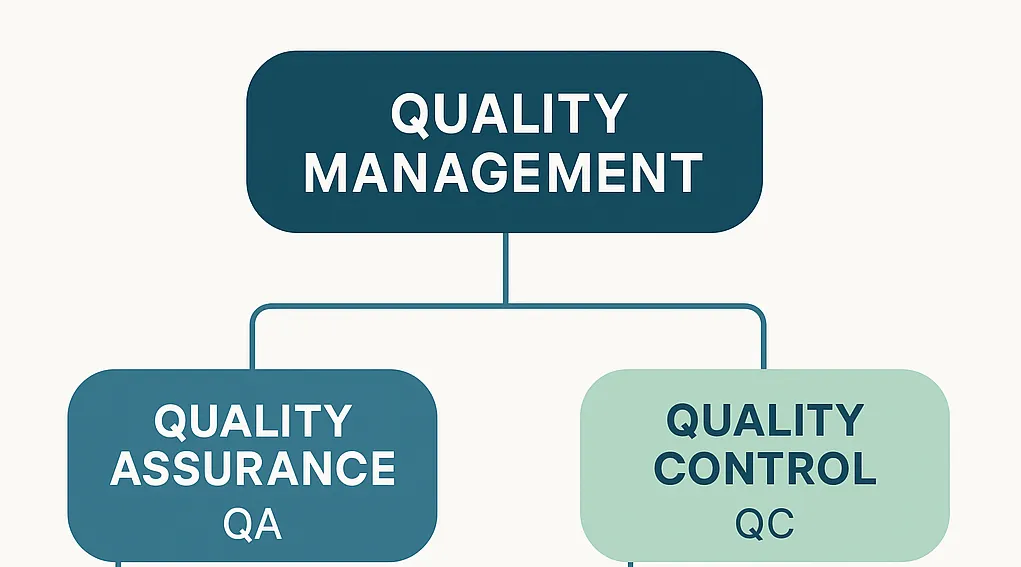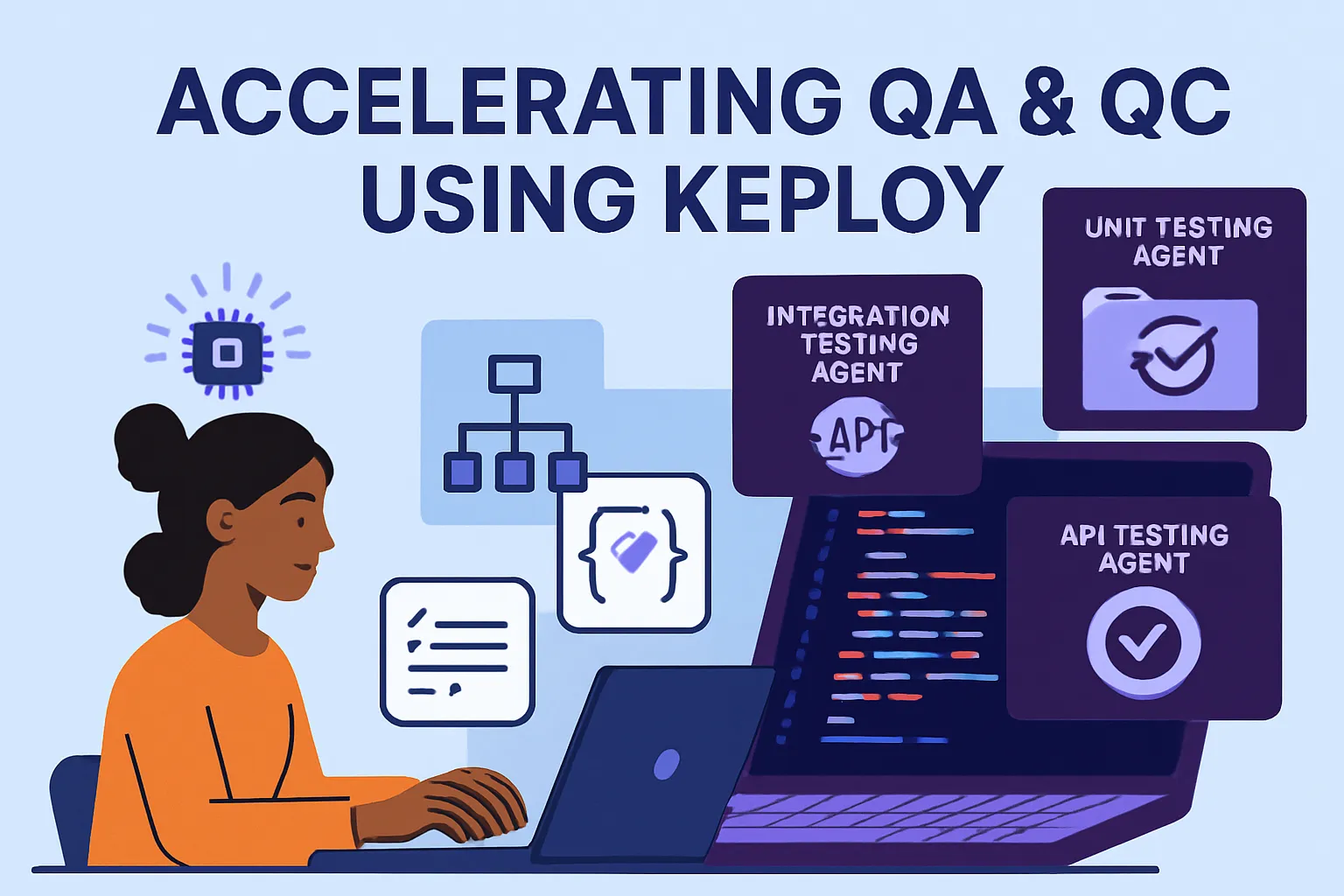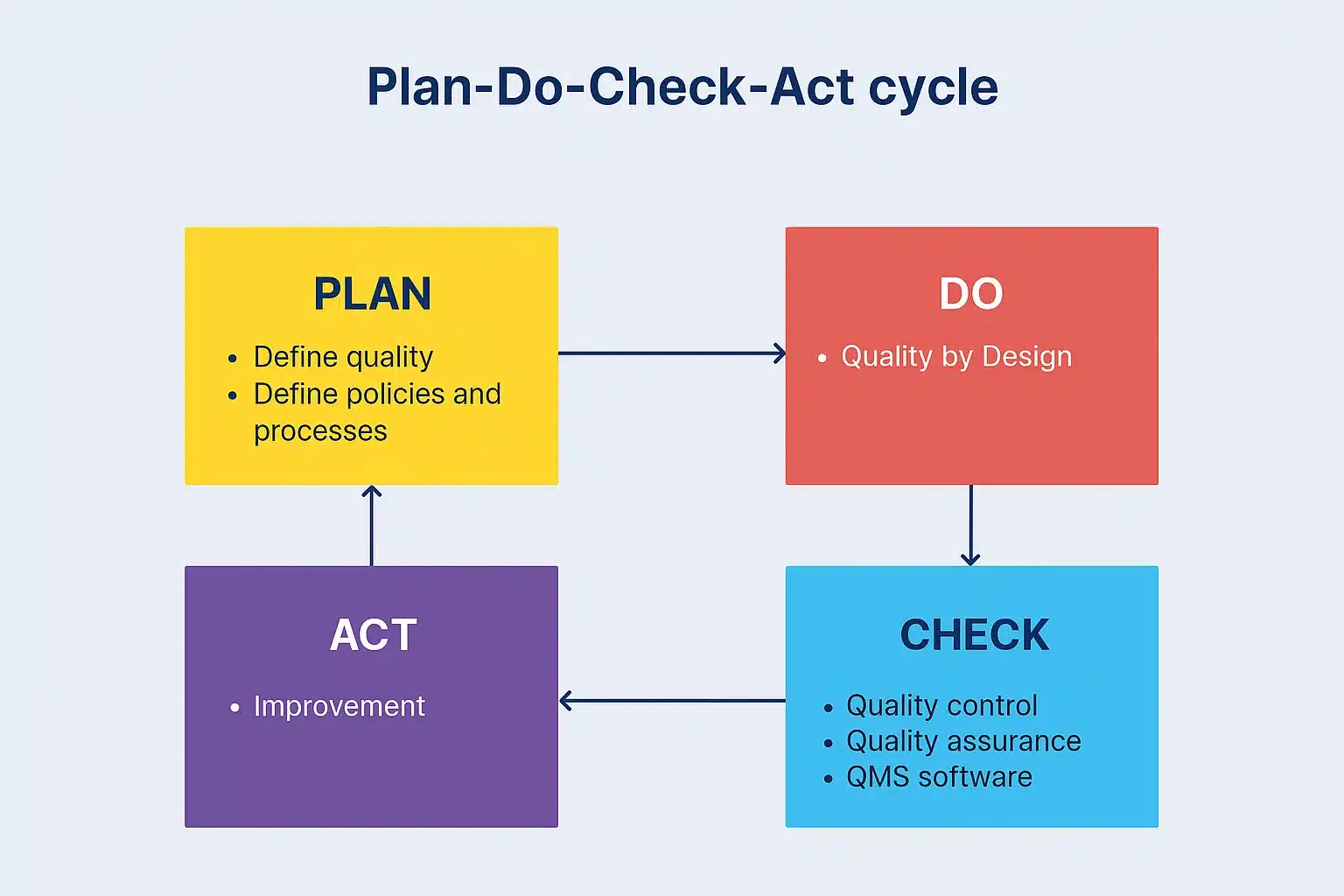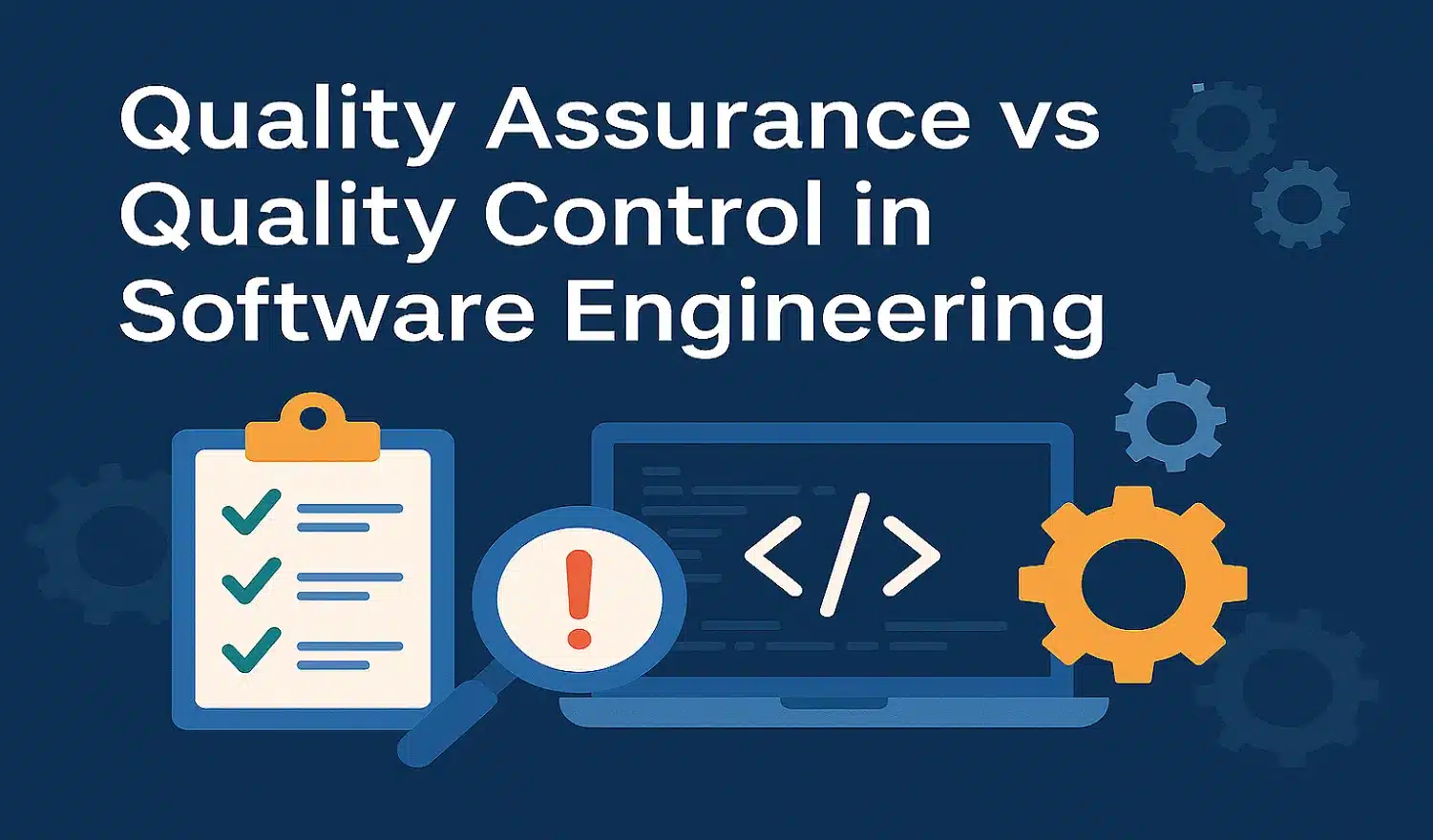In software product development, many teams tend to ignore quality metrics and focus more on quantity. Such teams face challenges when building for production. They end up pushing to production very low-quality software that is filled with bugs. These bugs alone irritate and drive away product users.
In 2022, research done by the Consortium for Information and Software Quality (CISQ) revealed that the cost of poor software quality in the US has grown to at least $2.41 trillion.
The question here is, how can one control and ensure that when building for consumers, they only build quality software that will attract users?
This blog has detailed answers to the above question. It provides solutions to low-quality issues. It covers details on Quality Assurance (QA) and Quality Control (QC) in software engineering, both of which are activities under Quality Management.

In this blog, we discuss the key aspects of QA and QC, examples, similarities, differences, importance, processes,approaches, and best practices for QA & QC.
So, let’s dive right into it.
What is Quality Assurance?
Quality Assurance (QA) is a quality management activity and process that ensures quality in the whole Software Development Lifecycle (SDLC). It is carried out during and after development to ensure products are bug-free. This process helps to prevent bugs from occurring.
The key aspects of Quality Assurance include the following.
-
QA focuses on prevention. Its goal is to find issues during the planning, designing, and development stages.
-
QA complies with software engineering standards, including coding standards, frameworks, reviews, audits, and methodologies such as agile and waterfall.
-
It is a continuously improving process, as it involves constant monitoring and process refinement to achieve better performance.
An example of QA is ensuring that unit tests are written in the early stages of development. For example, let’s examine the sample Python code below, which tests a login function to ensure password validation.
python
def validate_password(password):
return len(password) >= 8 and any(c.isdigit() for c in password)
def test_validate_password():
assert validate_password("secure123") == True
assert validate_password("123") == FalseThe above snippet defines a validate_password function for checking whether a password is at least 8 characters long and consists of at least a digit. The snippet also includes a test_validate_password function for verifying how correct the earlier function is while using examples of inputs.
Now, QA will define the process where tests like the one shown above are a must in a codebase before merging the pull requests (PR).
What is Quality Control?
Quality Control (QC) is a quality management activity and process that involves identifying and detecting defects, glitches, imperfections, or bugs in the final software product, then correcting them before delivering to the end-users. It is an important process as it ensures only quality products are released to the market.
The key aspects of Quality control include the following.
-
Its main goal is to identify defects in software products and then fix them.
-
It focuses more on the product to ensure it meets the essential quality and client requirements.
-
It involves manual and automated software testing.
-
QC validates the functionality, performance, and usability of a software product before delivering it to the market.
An example of QC in software engineering is writing automated tests to check actual functionality before releasing the product to the market. Let’s look at the Python example below.
python
def login(username, password):
if username == "admin" and password == "admin123":
return "Access granted"
return "Access denied"
def test_login():
assert login("admin", "admin123") == "Access granted"
assert login("user", "wrongpass") == "Access denied"The above snippet defines a function named login for checking if a given username is ‘admin’ and the password is ‘admin123’. If they match, then access is granted; else, access is denied. The test_login function is the QC where we verify that the login function’s behavior is correct. With QC, we ensure that these tests pass before the product is released to the market.
QA vs QC: Similarities between Quality Assurance and Quality Control

Quality Assurance and Quality Control have similarities, given that they are both techniques of quality management. This makes some individuals even use them interchangeably. Let’s have a look at some of the similarities below.
-
They both focus on delivering better quality software products.
-
Both ensure that the software functions as required.
-
Both QA and QC require skilled professionals to carry them out efficiently.
-
Both have the goal of delivering a bug-free experience to end product users.
-
Both processes continuously improve software development
-
They both involve planning and documenting tests
Now that we have examined the similarities, we will explore the key differences between QA and QC in the next section.
QA vs QC: Key differences between Quality Assurance and Quality Control
There are many differences between QA and QC, even though some individuals are unaware of their distinct differences and use them interchangeably. This section explores all of them. They are as listed in the table below.
| Aspect | Quality Assurance (QA) | Quality Control (QC) |
|---|---|---|
| Goal | Ensure no flaws exist in the process | Ensure the product meets quality requirements |
| Focus | Focus on the process used to build the software | Focus on the final product to verify quality |
| Bug Handling | Protect from bugs by preventing them | Find bugs and correct them in the finished product |
| Approach Type | Preventive technique | Corrective technique |
| Responsibility | Define quality standards and processes | Verify quality through inspections and testing |
| Coverage | Spans the entire software development cycle | Covers the software testing phase |
| Purpose | Depicts benchmarks and methods to meet client requirements and ensures they’re followed | Ensures benchmarks are followed and the product is satisfactory |
| Sequence | Performed before QC begins | Performed after completion of QA |
| Process Level | Considered a low-level process (process-wide) | Considered a high-level process (product-specific) |
| Techniques Used | Uses Statistical Process Control (SPC) | Uses Statistical Quality Control (SQC) |
| Nature | Proactive, that is, aims to prevent defects early | Reactive, that is, detects and resolves defects after development |
| Concept Scope | Narrower concept, as it is mainly process-focused | Broader concept, as it involves usability, reliability, and correctness of the product |
| Tool Type | A managerial tool that establishes quality policies and procedures | A corrective tool that identifies and resolves quality issues |
| Team Involvement | Worked on by all teams across development, management, and QA | Handled primarily by the testing team |
| Product Role | Helps to create the product according to quality processes | Helps to validate the product against requirements and user expectations |
Importance of Quality Assurance in Software Engineering
As seen from previous sections, Quality assurance is a very important process when managing quality in software development. Let’s have a look at some of the advantages that this process brings to you.
-
With Quality Assurance, defects are found early during development.
-
QA increases efficiency and code quality due to set structures and standards for developing a given software product.
-
It ensures the end product satisfies and retains customers.
-
It reduces final-stage software costs as defects are detected early.
-
If well implemented, it promotes collaboration among teams.
Importance of Quality Control in Software Engineering
Just like Quality assurance, Quality control also brings unique advantages to developers building software products while keeping quality in mind. Below, let’s have a look at the importance of quality control in software development.
-
It helps detect issues before the software product is released to the end users.
-
It ensures that the software has all the planned features and also works as planned. This ensures that all the software requirements are executed.
-
It is a final stage that determines whether the software is ready for the market or not.
-
It also reduces costs that would arise if defective software is released to the market.
-
This process helps review common errors, which are then documented and avoided in future developments.
The Quality Assurance Process

Quality Assurance is a process with defined steps followed. This section describes these steps so that you can follow them when implementing QA in your building process. This will guarantee that your product satisfies the set quality standards and specified customer requirements. The steps below are followed.
-
Planning
This early step is where quality objectives are set or defined. QA teams work together with other individuals involved and aim to benefit from the product to define quality goals, success metrics, and find necessary tools and resources.
-
Defining Processes
Here, processes that are to be followed during development and software testing are all documented. Some of these processes include the coding standards, protocols for code reviewing, and strategies for version control.
-
Training
Here, training is done to give the QA team knowledge of the processes defined in step 2. This is to ensure that all members are aligned with the set quality goals.
-
Auditing
To make sure that teams are following the defined processes in every stage of development, frequent quality audits are conducted in this stage. This is done to help detect bottlenecks, compliance issues, and ignite improvement.
-
Continuous Improvement
Considering the feedback from the auditing process, processes are improved iteratively. In this stage, the QA team considers agile methodologies, which help continuously improve the QA process for better quality results.
The Quality Control Process

Like QA, Quality Control is a process with defined steps to ensure it is effective and easy to implement. This process, when well implemented, following the steps in this section, helps systematically detect and remove issues in products that are ready to be pushed to the market so that only quality products reach the end users and thus promote retention and avoid customer complaints. Let’s have a look at the detailed steps to follow below.
-
Requirements definition
The process of testing software products initially requires an in-depth understanding of the software requirements, both functional and non-functional ones. These requirements are a foundation for writing software tests.
-
Test Planning
In this step, a detailed plan for testing is written down. The plan includes test cases, tools, how resources will be allocated, and the schedules and times of each activity.
-
Test Execution
This is the stage where all the software testing is done, both manual and automated testing. The documented test cases are run against the product, and the results are also documented.
-
Defect Logging
In case of any bug or defect while executing the tests, the bugs and defects are logged with details for the QC team to work upon.
-
Reporting
This is the final step in the Quality Control process. Here, the QC team generates test reports with details on the run test cases, found defects, the number of test cases that failed or passed, and the status of the software product, whether it is ready for market or not.
Quality Assurance vs Quality Control: Approaches
Now that we have examined the importance, differences, and processes of QA and QC, let’s have a look at some of the strategic approaches companies use for each process to achieve quality software products.
Quality Assurance Approaches
These are strategies implemented by organizations to set quality into the process of software development so that their end software products meet required standards and satisfy their consumers.
Below are some of the commonly used QA approaches.
-
Total Quality Management (TQM)
The TQM is based on a continuous improvement and development technique, which helps encourage all individuals or employees in the company to contribute to quality management.
-
Six Sigma
This technique leverages statistical methods and data analysis to reduce errors and bugs. It follows a structure called the DMAIC structure, representing Define, Measure, Analyze, Improve, and Control to optimize processes and ensure quality.
-
Plan-Do-Check-Act (PDCA)
Also known as the Deming Cycle, it is a QA technique for continuous improvement following the order below.
-
Plan: Set objectives and processes.
-
Do: Implement the plan.
-
Check: Monitor and evaluate the process.
-
Act: Make adjustments based on outcomes.

-
-
Lean Manufacturing
This approach is often used in manufacturing, hence its name. But it is also applied in QA software engineering. In this approach, QA teams minimize waste and increase efficiency during development to ensure quality in processes and maximize value to the end users.
-
The Theory of Constraints
This technique is used to find and remove constraints and issues in the software development process to improve the quality of the end software product.
-
Agile Methodology
The agile methodology approach promotes iterative development, continuous feedback, and close collaboration to deliver high-quality software products.
Quality Control Approaches
These are the various techniques used for finding, correcting, and preventing defects in final software products. They are utilized to ensure that the product is of set standards and offers user satisfaction.
Below are some of the common QC approaches.
-
Statistical Process Control
In approach, QC teams utilize statistical methods to offer real-time monitoring of production processes, which enables teams to find deviations early and implement corrective techniques before defects reach end users.
-
Taguchi Method
Developed by Genichi Taguchi, this QC approach emphasizes the use of statistical methods in software product design and development to ensure the product maintains better quality and high performance even under adverse conditions.
-
Inspection
This is a traditional QC technique where QC teams manually or automatically check the final product to ensure it is of the required quality standards. The approach involves functional checks, visual inspection, and automated bug detection.
-
Quality Circles
This approach involves groups of employees who come together to voluntarily identify, analyze, and solve quality-related issues to improve product quality.
-
Checklist
These are QC approaches that involve writing down a list of quality criteria that the software product must meet, and each item is checked off during review to ensure the necessary quality standards are met. This ensures completeness and accuracy.

Best Practices for Implementing QA & QC
If you want your company to maintain a high-quality product lifecycle, knowing the best practices is important for both QA and QC. In this section, we dive into some of the most effective practices used even by teams at top technology companies. Have a look at them below.
Quality Assurance (QA) Best Practices
-
Establish clear quality standards, guidelines, and procedures to ensure consistency across teams.
-
Integrate QA activities early across all development cycles to help find and correct bugs early.
-
Promote the use of Test-Driven Development (TDD) to ensure that software requirements are transparent and clear and reduce rework by detecting bugs early.
-
Create linkages between requirements and test cases to ensure better coverage and impact analysis in case of any changes.
-
Provide team-wide or company-wide training on quality assurance and its importance.
-
Use QA tools and automation tools like Keploy to reduce manual errors and promote efficiency.
Quality Control (QC) Best Practices
-
Set up comprehensive and detailed test plans that follow the defined software requirements, risks, and set goals. These plans should consist of functional and non-functional requirements, edge cases, and user scenarios.
-
Utilize modern software testing tools like Keploy, Postman, JUnit, or PyTest for better test coverage, efficiency, and reliability.
-
Track and analyze bugs based on their rate of occurrence and their severity levels to ensure close monitoring and severity-based fixing.
-
Perform exploratory testing where the software testers interact with the software product in order to find interaction and usage errors that might have been missed by the script tests.
-
Automate the entire software testing process in CI/CD pipelines to provide feedback during deployment stages, as well as save time and increase confidence for every code pushed to production.
Accelerating QA and QC using Keploy

Keploy is an open-source AI-powered software testing tool. It makes software testing easy and productive for QA & QC teams. Its AI-powered capabilities help software testers and developers generate unit and API tests quickly, thus increasing development as developers focus on writing code rather than writing tests.
Keploy creates test cases and data mocks/stubs from user traffic by recording API calls and DB queries, significantly speeding up releases and enhancing reliability.
It supports multiple programming languages, including Python, JavaScript, Java, Go, Rust, and C#. This makes it available for a wider community of software developers, thus no one is left out to work on long and time-consuming tasks manually, rather focus on core development tasks.
Keploy comes with AI-powered agentic tools integrated into it for streamlining the software testing process. These agentic tools work as intelligent assistants for developers during development. These tools include:
-
This AI-powered testing agent auto-generates reliable and validated unit tests as you write your code, ensuring stability and coverage. This agent assists developers as it automatically writes tests for each unit function in the developer’s codebase. This offers the developer time to think and work on other advanced functionalities rather than personally writing unit tests for each functionality.
-
The Integration testing agent automatically records and replays API calls with mocks for reliable and faster integration testing. This allows a developer to verify that different components in the software are communicating together, even without using real external services.
-
This agent automatically generates API tests from your documentation, covering edge cases and ensuring coverage. This ensures that all API inputs are tested and any hidden API defects are detected and fixed before pushing to production.
Conclusion
In this blog, we explored in detail Quality Assurance (QA) and Quality Control (QC), their similarities and differences, their importance in software engineering, the process and approaches of each technique, and the best practices to follow when implementing QA and QC in your organization.
With the rise of demand for better quality software products, the need for implementing QA & QC is unavoidable. Keploy with its AI-powered capabilities can help streamline this process so that your team focuses more on code writing and development rather than spending a lot of time writing tests.
Related Blogs
Top 10 AI Tools Transforming Software Quality Assurance
In this blog, you will discover how different AI tools like Keploy are revolutionising QA by enabling faster, smarter, and more reliable testing processes.
Mastering Test Coverage in Software Testing – Quality Over Quantity
This blog explores the concept of test coverage, its nuances, challenges, and the human element that goes beyond mere statistics.
QA Automation: Revolutionizing Software Testing
This blog dives deeper into QA automation, exploring the key components of QA automation, different types of QA automation testing, and what tools are used for QA automation.
Revolutionising Unit Test Generation with LLMs
This blog explores how Large Language Models (LLMs) like ChatGPT, DeepSeek, Grok, etc, can be used for auto-generating unit tests.
FAQs
Q1. Can one implement QA without QC?
No, QA prevents defects, but QC ensures defects aren’t shipped. So they both need to be implemented.
Q2. Is testing part of QA or QC?
Testing is primarily a QC activity, but test planning and test strategy fall under QA.
Q3. What’s the biggest benefit of QA?
Prevention of defects early in the development lifecycle saves time and cost.
Q4. What best tools are commonly used in QA and QC?
Keploy, Postman, Pytest, Selenium, Playwright

Leave a Reply